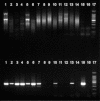Metabolic primers for detection of (Per)chlorate-reducing bacteria in the environment and phylogenetic analysis of cld gene sequences
- PMID: 15345454
- PMCID: PMC520896
- DOI: 10.1128/AEM.70.9.5651-5658.2004
Metabolic primers for detection of (Per)chlorate-reducing bacteria in the environment and phylogenetic analysis of cld gene sequences
Abstract
Natural attenuation of the environmental contaminant perchlorate is a cost-effective alternative to current removal methods. The success of natural perchlorate remediation is dependent on the presence and activity of dissimilatory (per)chlorate-reducing bacteria (DPRB) within a target site. To detect DPRB in the environment, two degenerate primer sets targeting the chlorite dismutase (cld) gene were developed and optimized. A nested PCR approach was used in conjunction with these primer sets to increase the sensitivity of the molecular detection method. Screening of environmental samples indicated that all products amplified by this method were cld gene sequences. These sequences were obtained from pristine sites as well as contaminated sites from which DPRB were isolated. More than one cld phylotype was also identified from some samples, indicating the presence of more than one DPRB strain at those sites. The use of these primer sets represents a direct and sensitive molecular method for the qualitative detection of (per)chlorate-reducing bacteria in the environment, thus offering another tool for monitoring natural attenuation. Sequences of cld genes isolated in the course of this project were also generated from various DPRB and provided the first opportunity for a phylogenetic treatment of this metabolic gene. Comparisons of the cld and 16S ribosomal DNA (rDNA) gene trees indicated that the cld gene does not track 16S rDNA phylogeny, further implicating the possible role of horizontal transfer in the evolution of (per)chlorate respiration.
Figures





References
-
- Achenbach, L. A., U. Michaelidou, R. A. Bruce, J. Fryman, and J. D. Coates. 2001. Dechloromonas agitata gen. nov., sp. nov. and Dechlorosoma suillum gen. nov., sp. nov., two novel environmentally dominant (per)chlorate-reducing bacteria and their phylogenetic position. Int. J. Syst. E vol. Microbiol. 51:527-533. - PubMed
-
- Bruce, R. A., L. A. Achenbach, and J. D. Coates. 1999. Reduction of (per)chlorate by a novel organism isolated from paper mill waste. Environ. Microbiol. 1:319-329. - PubMed
Publication types
MeSH terms
Substances
Associated data
- Actions
- Actions
- Actions
- Actions
- Actions
- Actions
- Actions
- Actions
- Actions
- Actions
- Actions
- Actions
- Actions
- Actions
- Actions
- Actions
- Actions
- Actions
- Actions
- Actions
- Actions
- Actions
- Actions
- Actions
- Actions
- Actions
LinkOut - more resources
Full Text Sources
Other Literature Sources
Molecular Biology Databases

